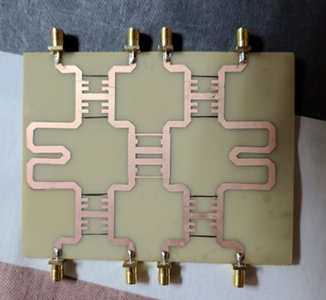Design and implementation of a patch-fractal antenna with phase control using Butler matrix
Main Article Content
Abstract
The study presents the successful design and implementation of a phase-controlled patch-fractal antenna using the Butler array. This work focuses on developing a laboratory prototype of a 4x4 array using microstrip technology. Theoretical conditions are established, and the theoretical basis of the microwave circuits that make up the matrix is described. Each element is individually designed, optimized, and simulated using specialized software (Ansoft Designer and Advanced Design System), and then its performance is verified by evaluating functional parameters. The tested designs are integrated into a single circuit to form the Butler matrix and are subjected to simulation and optimization before manufacturing. The functionality of the components is verified using a vector network analyzer. An analysis of the discrepancy between the measured values and the theoretical target parameters is performed, providing a comprehensive evaluation of the prototype's performance. Implementing the 4x4 Butler matrix together with the design of patch-fractal microstrip antennas has allowed practical phase control, demonstrating its viability in various applications. Results from both simulation and laboratory tests support the ability to direct the radiation lobe in various areas without the need for additional mechanical structures. The applicability of this antenna in short-range radar systems is highlighted, offering flexibility in addressing without compromising essential electromagnetic properties. For future applications requiring more precise control with a more significant number of radiation lobes, a Butler array with more ports is suggested.
Downloads
Article Details

This work is licensed under a Creative Commons Attribution 4.0 International License.
Authors who publish in this journal agree to the following terms: Authors retain the copyright and guarantee the journal the right to be the first publication of the work, as well as, licensed under a Creative Commons Attribution License that allows others share the work with an acknowledgment of the authorship of the work and the initial publication in this journal. Authors may separately establish additional agreements for the non-exclusive distribution of the version of the work published in the journal (for example, placing it in an institutional repository or publishing it in a book), with acknowledgment of its initial publication in this journal. Authors are allowed and encouraged to disseminate their work electronically (for example, in institutional repositories or on their own website) before and during the submission process, as it may lead to productive exchanges as well as further citation earliest and oldest of published works.
How to Cite
References
C. A. Balanis, ”Antenna theory analysis and design,” 3ra ed. New Jersey, 2005.
J. E. Barrera Dolores and J. L. Garcia Delgado, ”Sistemas de Radar de aproximacion para el AICM,” Instituto Politecnico Nacional, Escuela Superior de Ingenieria Mecanica y Electrica, Mexico, 2012.
A. Seco Prieto, ”Diseno de acopladores direccionales de microondas ˜ para matrices de Butler” (Proyecto fin de carrera), Universidad Autonoma de Madrid, Escuela Politecnica Superior, Madrid, Espana, 2009.
F. I. Shaikh and S. Bansidhar Akhade, ”Smart Antenna System Using 4x4 Butler Matrix switched beam network for 2.4 GHz ISM band,” International Journal of Application or Innovation in Engineering & Management, vol. 4, no. 3, pp. 278-280, Mar. 2015.
W. Bhowmik and S. Srivastava, ”Optimum Design of a 4x4 Planar Butler Matrix Array for WLAN Application,” Cornell University Library, vol. 2, no. 1, pp. 68-74, ISSN 1004-4821, 2010.
A. Cardama et al., ”Antenas,” 2.ª ed., Barcelona, Espana: Edicions UPC, 2002
J. S. Neron and G. Y. Delisle, ”Microstrip EHF Butler Matrix Design and Realization,” Electronics and Telecommunications Research Institute (ETRI Journal), vol. 7, no. 1, pp. 778-796, Dec. 2005.
R. D. Cerna Loli, ”Diseno e implementaci ˜ on de un sistema de beam- ´ forming utilizando una matriz de Butler compacta para las bandas AWS y PCS 1900 MHz,” Pontificia Universidad Catolica del Peru, Facultad de Ciencias e Ingenier´ıa, Lima, Peru, 2014.
M. I. Skolnik, Introduction to Radar Systems, 3ra ed., Singapur: Tata McGraw-Hill, 2001.
R. Garg, P. Bhartia, I. Bahl, and A. Ittipiboon, Microstrip Antenna Design Handbook. London, UK: Artech House, 2001.
J. Jimenez et al., ”Procedimiento de Diseno y Realización de Antenas ´de Parche en Tecnología,” 2011.
B. R. Mahafza, ”Radar Systems Analysis and Design Using MATLAB,” Chapman Hall/CRC, 2000.

